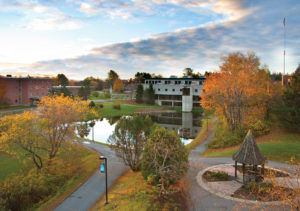Protecting public mission requires the courage to change …
 Despite the serious headwinds buffeting small, rural, tuition-dependent public colleges, they can survive—and even thrive—where leadership is proactive, courageous and doubled-down on our mission to serve.
Despite the serious headwinds buffeting small, rural, tuition-dependent public colleges, they can survive—and even thrive—where leadership is proactive, courageous and doubled-down on our mission to serve.
Unfavorable demographics, inadequate state funding, disruptive technologies and increases in costs can either choke us or motivate us to action to protect and expand critical postsecondary education opportunity.
The Vermont State Colleges Board of Trustees has chosen action. Northern Vermont University will result from the unification of two small state colleges that have successfully educated generations of students—mostly Vermonters—for over a century each. Lyndon State College and Johnson State College have been the access institutions for the northern and often most economically challenged region of our state. They are nationally recognized; Lyndon for its professional programs (Lyndon State College Atmospheric Sciences) and Johnson for its strong liberal arts focus (the Council of Public Liberal Arts Colleges-state designee). Each college is proud of its legacy, community and many loyal alumni.
Like many of their kind, Johnson and Lyndon have made painful cuts to match enrollment declines. Low state support (now at 14% of operating revenues) and contractually required increases in salary and healthcare benefits of around 4% annually have put stress on annual budgets with little relief in sight. And yet the need for these colleges only grows in Northern Vermont: The disparity in college continuation rates between first-generation students and their peers is stark in this region, with county-level continuation rates as low as 42% for first-generation students, compared to statewide rates of 52% for first-generation and 72% for non-first generation students. Economists report a “tale of two Vermonts” where, in this area, jobs and wages have remained stagnant since the Great Recession. The central role of these institutions in the region’s economic and cultural livelihood makes both their survival and their ability to deliver quality postsecondary education imperatives.

Johnson State College
After a survey of this landscape, the Vermont State Colleges System Board of Trustees articulated new priorities to boost enrollments and revenues, and to make the system more efficient through consolidated business processes and shared resources. It also charged two pairs of colleges in the system to develop strategic alliances that would create efficiencies and expand what is available to students.
A dynamic alliance began to develop between Johnson State and Lyndon State Colleges, whose leaders saw potential for filling out upper level courses and improving on-time degree completion by expanding cross-enrollment. The colleges invested in connected classrooms, which opened opportunities for students and faculty to collaborate.
Months into this new alliance, vacancies in the presidency of Lyndon State College and in two dean positions at Johnson State College prompted trustees to consider the practicality of shared leadership across the two campuses. Such a move would reduce administrative costs and further advance the alliance that had the potential to improve and expand student opportunity. The board immediately charged the chancellor with making a recommendation on the feasibility of a single leadership team, a closer alliance and the potential unification of the two colleges.
We took extensive input from campus and regional stakeholders,  conducted a review of national models of collaborations and mergers in higher education, and studied the legal and financial impacts of unification. We convened a Unification Advisory Committee, representative of both campuses and alumni, to identify the many tasks that would need to be undertaken in a successful unification. At the end of this process, on Sept. 29, 2016, the board unanimously approved a resolution to unify the two colleges.
conducted a review of national models of collaborations and mergers in higher education, and studied the legal and financial impacts of unification. We convened a Unification Advisory Committee, representative of both campuses and alumni, to identify the many tasks that would need to be undertaken in a successful unification. At the end of this process, on Sept. 29, 2016, the board unanimously approved a resolution to unify the two colleges.
Unification of the two colleges provides a resource multiplier: Rather than two faculties of approximately 50, there will be one faculty of 100. The student body will double to nearly 3,000. Student support staff will collaborate and share best practices. Students will have more classes to choose from and more opportunities to engage with a larger student body in activities on both campuses. A coordinated, rather than competing, admissions approach will better target new students. Northern Vermont University will open new doors for students by combining opportunities in academic and experiential learning and by providing a larger and more diverse faculty.
The financial basis for unifying the two colleges into one is compelling. Administrative savings, combined with projected new revenues, will put the budget on a positive trajectory. Projected implementation costs, including branding, marketing and information technology improvements, will be one-time. Faculty development, particularly in learning technologies, will be an ongoing priority; the force multiplier of a larger and more diverse faculty should foster development of distinctive new programs attractive to a broader student audience. Stronger finances after unification will best position both campuses to address external challenges and devote limited resources to students and learning.
The creation of “Northern Vermont University,” with campuses in Johnson and Lyndon, has been approved by the board. The name is grounded in the pride our students, faculty and staff have in their local communities. It expresses all that our two colleges together have to offer and what they aspire to be. It expresses our confidence in this new college’s ability to compete for students and grants. Most importantly, by including “Northern” we are putting a stake in the ground and committing to work together with the region to create a brighter future in which our university plays a central role.
This move is not without its risks. The unified budget scenario will provide a positive operating result, but not immediately. The roles of faculty and staff, distinctiveness of academic programs, and full complement of student opportunities will become clarified over time. A transition process of this magnitude involves both creativity and uncertainty. The bigger risk, though, is inaction.
Effective leadership, continued involvement by all community members, active support from the system, a laser-focus on the new university’s mission, and optimism grounded in all of the above will combine to make this unification a success.
And the most significant dynamic that will power us forward to a successful unification is the love of place, the attachment that students, staff, faculty and alumni have for their own institutions. In our unification, we have not asked Lyndon State College or Johnson State College to give up their campus, their mascots or sports teams, or even their unique identities. We have asked them to bring that same passion to the unification effort so that we can both preserve and strengthen all that they love about their college.
Northern Vermonters are known for their resourcefulness—for making things work well with what they have. We hope in the new year our state and national leaders will also recommit to the public higher education mission and recognize not only our proactive moves to strengthen our institutions, but the value they add to the state’s economy.
Our colleges are institutions of opportunity. We believe in the promise of access to higher education and the transformational power it holds for individuals and for our state. By keeping our focus on what is best for our students, and future generations of students, we know we will continue to deliver on the university’s mission, for the benefit of Vermont.
Jeb Spaulding is chancellor of the Vermont State Colleges System.
Related Posts:
A Four-Step Plan to “Right-size” the Curriculum
The View from Vermont Gov. Shumlin
Implementing System-Level Graduation Standards
[ssba]
